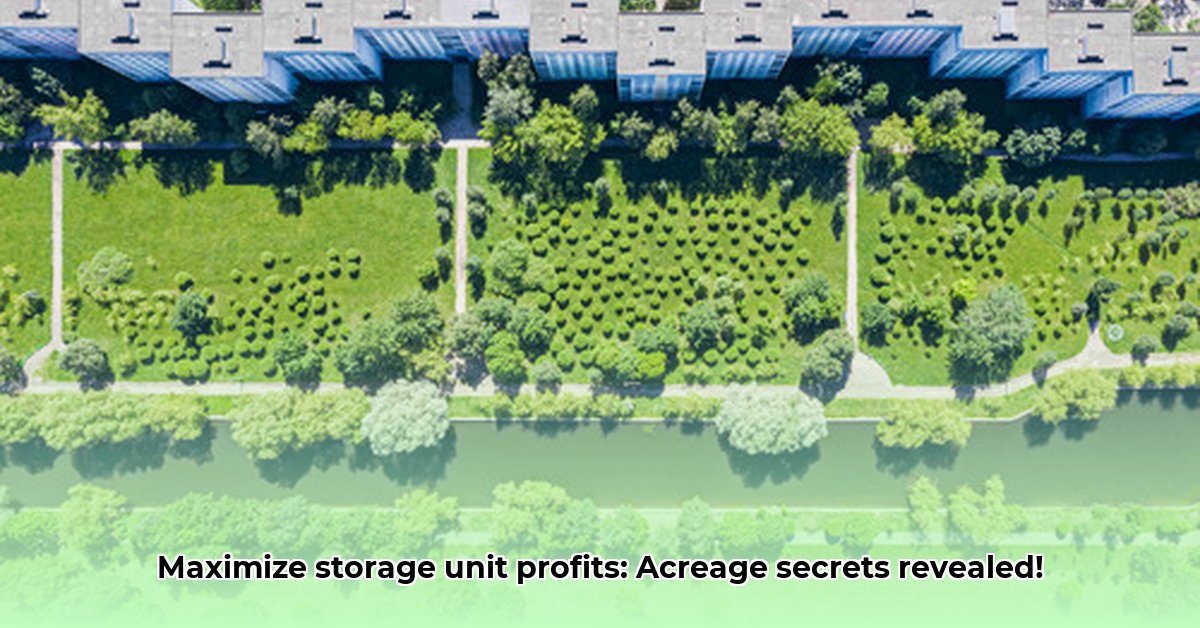
Figuring out the optimal number of storage units per acre is crucial for maximizing profitability in the self-storage industry. This instructional guide provides a step-by-step approach for developers, investors, operators, and local government officials to achieve higher density while adhering to regulations and mitigating risks. For additional resources on commercial properties, check out this helpful guide on commercial warehouse rentals.
Understanding the Factors Affecting Storage Unit Density
Determining the precise number of storage units per acre isn't a simple calculation. It requires a comprehensive understanding of several interconnected factors:
Unit Size and Mix: The size and variety of units (e.g., 5x5, 5x10, 10x10, 10x20) significantly influence density. Smaller units allow for more units per acre but may yield lower revenue per unit, while larger units generate higher revenue per unit but reduce overall unit count. A balanced unit mix, informed by market research, is key.
Non-Rentable Space: Driveways, office space, walkways, and utility areas consume a considerable portion of land, often up to 50%. Efficient facility design is crucial to minimize this non-rentable space and maximize rentable square footage.
Zoning Regulations: Local zoning laws dictate building height limits, setbacks (distance from property lines), parking requirements, and other restrictions that directly impact unit density. Compliance is paramount and should be a primary consideration in the early planning stages.
Market Demand: Thorough market research is essential to determine the optimal unit mix based on local demand. Urban areas might favor smaller units, while suburban areas could see a higher demand for larger units and vehicle storage.
A Step-by-Step Guide to Optimizing Storage Unit Density
This structured approach will guide you through the process of maximizing storage unit density while adhering to regulations and mitigating risks.
Step 1: Thorough Site Analysis and Due Diligence
Begin with a detailed assessment of your land. Identify any geographical constraints (hills, wetlands), soil conditions, and existing infrastructure (utilities, access roads). A professional survey is highly recommended.
Step 2: Navigate Zoning Regulations and Secure Necessary Permits
Consult with local zoning authorities to understand building height restrictions, setbacks, parking requirements, and other applicable regulations. Obtain all necessary permits before commencing construction. Engaging a zoning consultant can significantly streamline this process.
Step 3: Develop an Efficient Facility Design
Work with an architect or experienced self-storage designer to create a layout that maximizes rentable space while ensuring efficient access for tenants and maintaining safety standards. This includes optimizing the placement of units, driveways, walkways, and office areas.
Step 4: Determine the Optimal Unit Mix Based on Market Research
Conduct thorough market research to identify the demand for different unit sizes in your target area. This analysis should inform the optimal unit mix to maximize both occupancy rates and revenue generation.
Step 5: Financial Planning and Risk Assessment
Develop a detailed budget that includes construction costs, operating expenses (insurance, taxes, utilities), and projected rental income. Conduct a thorough risk assessment to identify potential challenges and develop mitigation strategies. Consider factors such as construction cost increases, zoning changes, and competition.
Risk Assessment Matrix for Self-Storage Development
Understanding and mitigating potential risks is crucial for a successful self-storage venture. The following matrix outlines key risks, their probability, impact, and suggested mitigation strategies.
| Risk Factor | Probability | Impact | Mitigation Strategy |
|---|---|---|---|
| Soaring Construction Costs | Medium-High | High | Secure multiple bids from reputable contractors; explore cost-effective building materials. |
| Zoning Delays and Permitting Issues | Medium-High | High | Engage experienced zoning consultants; maintain open communication and proactive collaboration with authorities. |
| Low Occupancy Rates | High | Medium-High | Conduct comprehensive market research; implement a competitive pricing strategy and aggressive marketing plan. |
| Stiff Competition | Medium | Medium | Differentiate your facility through unique amenities, superior customer service, and strategic location. |
| Unexpected Regulatory Changes | Low | High | Stay informed about regulatory updates; build a strong relationship with regulatory bodies; explore proactive adjustments in your business model. |
Key Considerations for Maximizing Profitability
Adaptability: The self-storage industry is dynamic. Remain flexible and adapt your strategies to changing market conditions and customer demands.
Professional Advice: Seek expert advice from experienced professionals in self-storage development, design, and finance.
Continuous Learning: Stay informed about industry trends, best practices, and technological advancements.
By following this comprehensive guide and conducting thorough due diligence, developers and operators can effectively maximize the number of storage units per acre, leading to significant increases in profitability. Remember that thorough planning and understanding local regulations are essential elements in a successful self-storage venture.